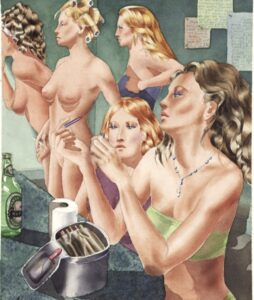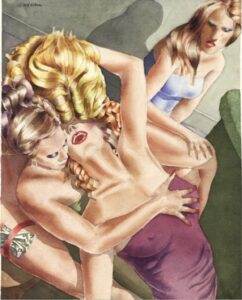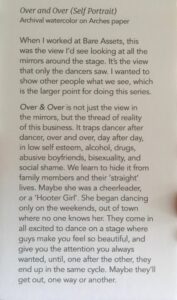
Madina Stepanchenko
Some lives are lived under such brutal, unrelenting conditions that they are unimaginable to the majority of us, and how a person survives at all can seem incomprehensible. When it is an artist who has endured those circumstances they can provide a foundation for work that realizes art’s fullest potential in fusing creative expression, and the most volatile extremes of human experience. Rarely, the stories, incidents and memories poured into that practice result in work of such honesty and revelation, that it can alter our understanding of trauma, resilience, and even our cultural standards and judgements. Donna Nadeau’s paintings are of that uncommon and imperative caliber.
Donna Nadeau was Born in 1955, in Kennebunkport, Maine, and raised there by her Lebanese father and American mother. From an early age Nadeau was subjected to discrimination—in majority-white New England, due to her dark skin. This fomented a sense of difference, and a decline in self-esteem that would hamper her confidence later in life. Nadeau’s early proclivity for art was supported by her parents, but economic straits made it a prohibitive option. After high school while modeling for art classes to earn money, and married with a young son, she met Dewitt Hardy, a prominent Maine watercolorist for whom she posed in exchange for the drawing lessons she still longed for. He would remain her mentor, and friend until his death in 2017. But it was in 1980, while on an extended trip to the Florida Keys, and in need of funds to take her family back to Maine, that Nadeau took a job which would become the catalyst for an extraordinary journey into the underworld of strip bars, drug deals, gentleman’s clubs, and the dangerous sub culture that roiled around them.

What had been intended as a one weekend earner, dancing topless at Bogart’s Speak Easy in Marathon, became a decades-long odyssey in which Nadeau found herself subject to the lures and consequences of those environments. There was an abundant income—in the form of hundred dollar tips—that was funneled through clubs from by drug runners, and lavished on dancers. She had to grapple with the expectations and appetites of the men who paid to be close to her, and who were frequently unrestrained in their behavior and requests. Nadeau embarked on nomadic quests for better clubs, and higher pay, that took her from coast to coast, dancing in Las Vegas, California, and across Florida. In the top venues, management standards treated her like a commodity. For example, The Cheetah, in Atlanta, (a large club that ran a hundred girls a night) required weigh-ins, and constant examinations to ensure that nails, and tan lines were correctly applied. Perhaps most grievously, Nadeau was betrayed by those she considered friends, which led to her ensnarement in a DEA sting operation. Of her decision to leave for Nevada that year, Nadeau recalls:
“I Packed my VW Bug, with my boyfriend, my ex-husband Danny (pre Spiderman,) my three year old son, Keeya, and all our shit, in a trailer. But the car couldn’t pull it all so we stopped at a fire station in Gainesville, and gave most of our stuff away. We stuffed the rest in with the four of us, then drove to Vegas—not knowing what would happen when we got there.”
The most lucrative places to work in were nude, table dancing establishments that selected only the prettiest girls, and upheld strict rules—customers had to stay two feet away; performers’ knees couldn’t be more than four inches apart. Cheaper, topless bars allowed physical contact, lap dances, and had private rooms where blind eyes were turned to more extreme engagements. Working in the latter exposed the women to greater potential danger, and more insistent interactions with punters, which were increasingly difficult to bear. In time, narcotics and alcohol lent the numbing ability to get through each shift, and to make men believe that Nadeau enjoyed their company, while they forgot their wives, and she earned their cash. Substance addiction took a toll on her health, and precedence over her son’s schooling, and wellbeing; while impaired decisions over boyfriends, and partners led to physical abuse, shootings, training attack dogs, self-protective exile, and eventually an intervention that saved her life. On the difficulties of her work, Nadeau explains:
“You drink for a living—because that’s what it takes to do the job. It’s hard to act as though you like the work, and tolerate men hitting on you, and saying disgusting, degrading stuff to you when you’re sober! You start out drinking in the dressing room to get the strength to walk out and deal with it all. Then you sit and drink with them to get them to buy dances, and spend more dollars on you. Then they come back because you made them feel wanted in ways that their wives or girlfriends don’t. Meanwhile there’s another drink at another table waiting for you, and a group of guys in a bachelor party who want you to do a shot with them. So by 1am you’re wasted, but you still have three more hours to dance, while trying not to fall off stage. So what are the options? Some coke to sober you up. It’s a delicate walking chemistry set, balancing between too drunk and too sober, or too wired out, until the DJ yells “last call” and it’s over again for one more night.”

And yet, among these challenges, there were aspects of Nadeau’s world that sustained and enhanced her. The conviviality between the girls who were her colleagues was familial. They would share days off together on sea cruises—sometimes hosted by kinder, reliable clients—or at beach picnics with their children. There was a wry thread of humor that helped assuage the hardships. Of the bonds she shared with her companions, Nadeau notes:
“In a small club where it’s ‘us against them’ (clients,) there’s a camaraderie. If a girl is drunk and losing her $$$ out of her garter all over the club, the other girls will pick it up and give it back to her. They might also grab the rest from her garter and shove it in her locker so she doesn’t lose anymore. Otherwise, a customer, or a new girl, or a girl from out of town just there to make $$$ for the weekend, might find it and keep it. It’s the “house girls’ (core girls at the club, in the little family) who support each other.”
Nadeau continues:
“I’m bisexual (like most strippers) and an old girlfriend who lived with me and my boyfriend tracked me down recently; she left me for a biker. I’d forgotten about all those girls with the ‘property of so and so’ tattooed on their backs.”

And there were instances of high glamor, such as in 1994 when Nadeau, and other dancers from across America were flown to New Orleans, and driven in limousines to the opening of Crescent Cabaret. There, the “house mother” drilled her charges that, “it’s your money, it’s just in their pockets.” They learned the nuances of their profession, and became shrewd prospectors of the male psyche; they understood the power of financial autonomy, and how to achieve it, so that in a reversal of economic status, it was common for men to be the casualties of feminine intellectual superiority. And while Nadeau competed with the others for the best tables to dance on, or the wealthiest customers, the women were unified in protecting their turfs. If a prostitute joined the troupe, “we’d run those girls off.” Strippers didn’t want their business undercut by direct offers of sex—something that johns thought they might receive from strippers later in the evening. On the brinkmanship of her environments, Nadeau explains:
“All players in this game have their own agenda. The guy (unless he’s a regular and knows the girls as ‘people’) think the women there are cheap sluts who he can pay enough to get sex. He thinks he holds all the power because he has all the money. He acts all nice and sweet, as he’s drinking and escaping his real life. Meanwhile the girls are telling him some compliment about his dress or personality, or manliness, and making him feel even more important and appreciated. This is their power, and they use it to take his dollars by making him think it’s his idea to give it to them. The whole time he’s thinking that he’s the one in charge, while they plan his evening for him, and laugh in the dressing room about how much money they took from him.”
Nadeau and her co-workers couldn’t avoid being tarnished by societal shaming and scorn which otherized and diminished them, and led to a secretive existence in the shadows, and an unwillingness to share with anyone what they did for a living. But contrastingly, they were also powerful frontline warriors in the struggle for female empowerment, taking hits—literal and figurative—while suffering and resisting terrible depredations, long before the current shift in gender discourse. They represented a courageous amazonian vanguard of sacrifice and strength, dressed in the stage costumery that was the armor of their kin. Their unabashed confidence in the beauty of their bodies (that remain the battlefields of so much cultural conflict) ought to be acknowledged. Theirs’ is an unsung chapter in the dismantling of female denigration that is only now coming to fruition through the “Time’s Up” and “Me Too” movements.

Through all of this, Nadeau never lost sight of her artistic compulsion, and during those many years she photographed countless backstage scenes; her co-dancers in quiet moments, or the full glare of showtime; and the customers. Her intention was to document a fascinating world—its colorful habitués, power structures, and sometimes harrowing psychologies—from the unheard perspective of the women around whom the entire cavalcade revolved. In the early 2000s towards the end of her dancing career, Nadeau began exploring these themes in subtleties of form and palette, endowing her watercolor vignettes with the atmospherics of her experiences; their physical and social architectures; and the financial thrum that underpins the industry. Her paintings are titled as suggestively as the scenarios that they depict—The (Dreaded) Lickers, The Hustle, Pay to Watch, and Blood For The Vampires. Nadeau’s is not erotic art, nor pornographic, nor even sexy. It is an anthropological study into a little understood environment by someone who knows its heart. Her oeuvre is a reclamation, a political statement of female emancipation.
Nadeau’s technical prowess with the medium enables her to strike exquisite details in facial expressions, the torque of muscle and sinew, and anatomical gestures that evoke aspects of the dancers’ circumstances—weariness, determination, cynicism, dynamism, grit, showmanship or exhaustion. Despite the dazzling, jeweled tones in many of the paintings there are elements that contrast with the glittering facades and stage lighting—perfunctory dressing-room counters, dreary locker-rooms, drab walls, and darkened corners. The artist utilizes these motifs not only as a pictorial device to structure and contrast her compositions, but to mirror the poignancy and contradictions that she has learned and lived through adversity. Nadeau’s paintings take us into a world as exhilarating as it is soul-crushing—sharing the grind and oil, the anguish and the thrill, of its dark machinations.
Madina Stepanchenko is a journalist, art writer and documentary filmmaker. She is based in New York.

